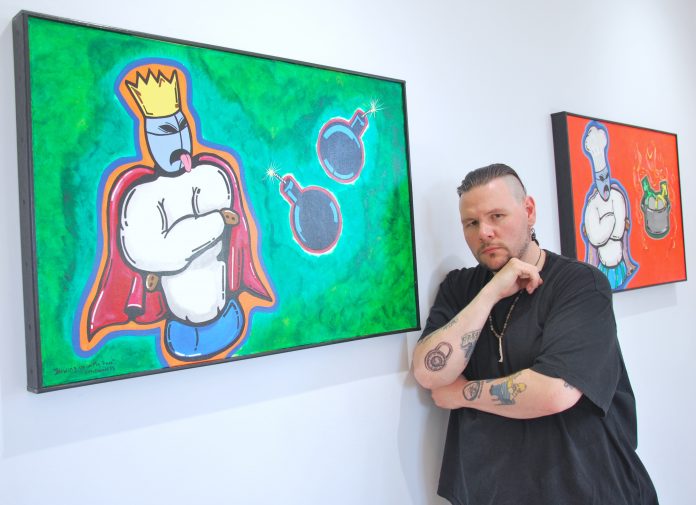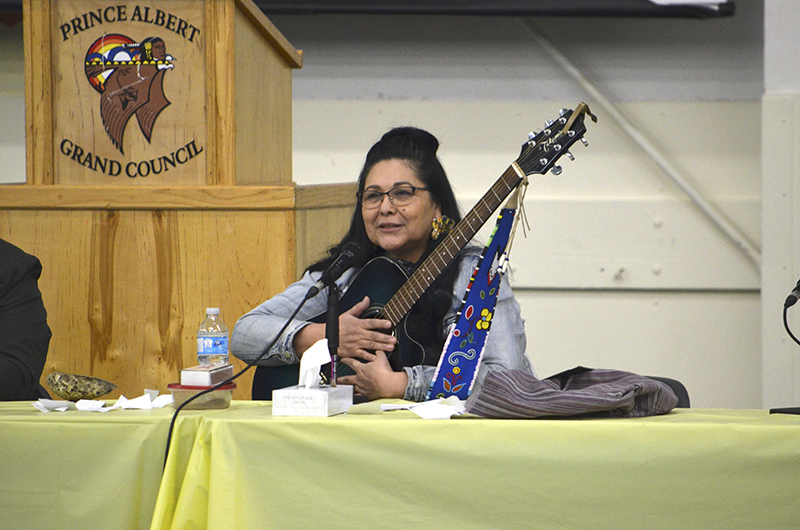
Two local Indigenous artists have received financial support from the Saskatchewan Arts Board to explore and communicate elements of their identities through their art.
John McDonald and Violet Naytowhow are both embarking on projects that will explore part of what it means to be an Indigenous person. Naytowhow is examining the traditions of the past, while McDonald is taking a look at the experience of the Indigenous person in the 21st century.
“The project I’m going to be working on is creating a series of painting dealing with Indigenous life in the 21st century and some of the issues we as Indigenous people have been dealing with.”
McDonald’s project is taking a particularly close look at the last ten years. It’s tackling topics such as missing and murdered Indigenous women, the backlash faced by water protectors protesting pipeline development, the Gerald Stanley verdict and racist online comments. His work, though, will also look at topics such as the return of traditional practices such as Indigenous tattooing, and the power seen in forms of protest such as the Justice for our Stolen Children camp.
“The reason I want to share these stories is this is who we are as Indigenous people. Those of us who are on the front lines fighting, this is our reality,” he said.
My role as a warrior, my role as an activist and as an artist, these are the tools I have to share our culture and our experience and to give a voice to … people who don’t feel like they have a voice. That’s why I wanted to capture these images in my style.”
McDonald’s paintings will be done from a contemporary style, using cubism and other surrealistic art forms.
McDonald has also received other recognition from the Arts Board. Thy recently purchased one of his pieces, a painting inspired by Keith Haring and from late 1970s era graffiti styles.
It’s combined those styles, which often use bright, solid colours and geometric shapes, with a darker colour palette of black, grey and lavender.
“I was very honoured that they chose this piece out of the ones I submitted for the permanent collection,” he said.
“The Saskatchewan Arts Board is a huge boost. I deeply thank the Saskatchewan Arts Board, not only for the grant but for the purchase. That support helps us grow as artists, and encourages us to share our narratives.”

Naytowhow, meanwhile, is using her grant funding towards an exploration of a traditional aspect of her culture. She’s looking to take some traditional songs and pair them with stories, presenting the works in a series of recordings and possibly a show.
“I’ve been partaking with medicine harvesting training in the past few years,” she said.
“There are particular songs that are given to plants. Before they sing a song, they tell a story about the plant, how it came to be, how it arrived and what it’s about.”
Those songs are sung as they go to pick the medicine plants.
Other songs she’s working on will tell stories about life in northern Saskatchewan.
“I want to make a portion … the traditional, cultural side of music,” she said.
She’s going out into the community, mostly in Sturgeon Lake, to learn more about the ceremonies and to prepare.
Naytowhow will be sitting with elders, giving them gifts and going through the cultural protocol in order to learn the stories and the songs. She talked about learning how to sing songs organically, songs that are based on from generations back.
That organic singing, she said, sends messages from the singer’s ancestors.
As for the songs about northern Saskatchewan, Naytowhow is working with Lucy James of Jam Street Music to write and develop the music.
“We’re going to rehearse in her studio and then develop a show from the songs I make,” Naytowhow said.
That show will incorporate both the songs and the storytelling element. She’s hoping to get out to surrounding communities to share those elements of her culture with children through workshops and concerts.
“I want to give them accurate and important information,” she said. “So I have to spend a little bit more time sitting and listening and getting to know what it is I should be sharing, and how I should be sharing it when I do get out there.”
Naytowhow sees her music moving in that direction, away from performing, and more towards teaching the next generation.
“I’m moving towards that way of thinking with music,” she said.
Not to go out and deliver a lot of concerts, but more to teach about where these songs come from.”

